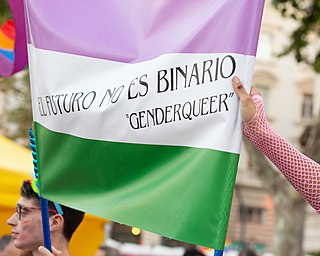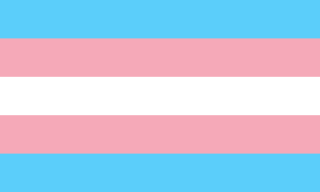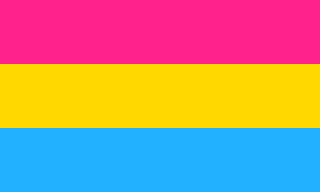
A rainbow flag is a multicolored flag consisting of the colors of the rainbow. The designs differ, but many of the colors are based on the seven spectral colors of the visible light spectrum.

The LGBT community is a loosely defined grouping of lesbian, gay, bisexual, and transgender individuals united by a common culture and social movements. These communities generally celebrate pride, diversity, individuality, and sexuality. LGBT activists and sociologists see LGBT community-building as a counterweight to heterosexism, homophobia, biphobia, transphobia, sexualism, and conformist pressures that exist in the larger society. The term pride or sometimes gay pride expresses the LGBT community's identity and collective strength; pride parades provide both a prime example of the use and a demonstration of the general meaning of the term. The LGBT community is diverse in political affiliation. Not all people who are lesbian, gay, bisexual, or transgender consider themselves part of the LGBT community.

Non-binary and genderqueer are umbrella terms for gender identities that are not solely male or female. Non-binary identities often fall under the transgender umbrella since non-binary people typically identify with a gender that is different from the sex assigned to them at birth, though some non-binary people do not consider themselves transgender.

The bisexual flag, also called the bisexual pride flag, is a pride flag representing bisexuality, bisexual individuals and the bisexual community. According to Michael Page, the pink stripe represents attraction to the same sex, while the blue stripe represents attraction to the opposite sex. The purple stripe, the resulting "overlap" of the blue and pink stripes, represents attraction to both sexes.

LGBT culture is a culture shared by lesbian, gay, bisexual, transgender, and queer individuals. It is sometimes referred to as queer culture, while the term gay culture may be used to mean either "LGBT culture" or homosexual culture specifically.

The Transgender flag is used by people, organizations and communities to represent pride, diversity, rights and/or remembrance within the transgender community. Usage is similar to the original rainbow flag but specific to the transgender community.

A pride flag is any flag that represents a segment or part of the LGBT community. Pride in this case refers to the notion of LGBT pride. The terms LGBT flag and queer flag are often used interchangeably.
Over the course of its history, the LGBT community has adopted certain symbols for self-identification to demonstrate unity, pride, shared values, and allegiance to one another. These symbols communicate ideas, concepts, and identity both within their communities and to mainstream culture. The two symbols most recognized internationally are the pink triangle and the rainbow flag.

Cheer, Dorothy, Cheer! is a non-profit organization based in Minneapolis, Minnesota. The organization was founded by three gay men in 2002 to promote diversity, raise HIV/AIDS awareness, and raise money for other non-profit organizations.

The rainbow flag or pride flag is a symbol of LGBT pride and LGBT social movements. The colors reflect the diversity of the LGBT community and the spectrum of human sexuality and gender. Using a rainbow flag as a symbol of LGBT pride began in San Francisco, California, but eventually became common at LGBT rights events worldwide.
LGBT linguistics is the study of language as used by members of LGBT communities. Related or synonymous terms include lavender linguistics, advanced by William Leap in the 1990s, which "encompass[es] a wide range of everyday language practices" in LGBT communities, and queer linguistics, which refers to the linguistic analysis concerning the effect of heteronormativity on expressing sexual identity through language. The former term derives from the longtime association of the color lavender with LGBT communities. "Language", in this context, may refer to any aspect of spoken or written linguistic practices, including speech patterns and pronunciation, use of certain vocabulary, and, in a few cases, an elaborate alternative lexicon such as Polari.

Lesbian, gay, bisexual, and transgender (LGBT) people in the U.S. state of Pennsylvania enjoy most of the same rights as non-LGBT residents. Same-sex sexual activity is legal in Pennsylvania. Same-sex couples and families headed by same-sex couples are eligible for all of the protections available to opposite-sex married couples. Pennsylvania was the final Mid-Atlantic state without same-sex marriage, indeed lacking any form of same-sex recognition law until its statutory ban was overturned on May 20, 2014.

The pansexual flag is a pink, yellow and cyan flag, designed as a symbol for the pansexual community to increase its visibility and recognition, and distinguish itself from bisexuality.
Discrimination against non-binary people, people who do not identify exclusively as male or female, may occur in social, legal, or medical contexts.

Queer fashion is fashion among queer and nonbinary people that goes beyond common style conventions that usually associate certain colors and shapes with one of the two binary genders. Queer fashion aims to be perceived by consumers as a fashion style that focuses on experimenting garments based on people's different body shapes instead of following the restrictions given by gendered clothing categorization.
Various lesbian flags have been used to symbolise the lesbian community. Since 1999, many designs have been proposed and used. Although personal preferences exist, as well as various controversies, no design has been widely accepted by the community as the lesbian flag.
Non-binary or genderqueer is a spectrum of gender identities that are not exclusively masculine or feminine—identities that are outside the gender binary. Non-binary identities can fall under the transgender umbrella, since many non-binary people identify with a gender that is different from their assigned sex. Another term for non-binary is enby. This page examines non-binary characters in fictional works as a whole, focusing on characters and tropes in cinema and fantasy.
Various pride flags have been used to symbolize gay men. Rainbow flags have been used since 1978 to represent both gay men and, subsequently, the LGBT community as a whole. Since the 2010s, various designs have been proposed to specifically represent the gay male community.











